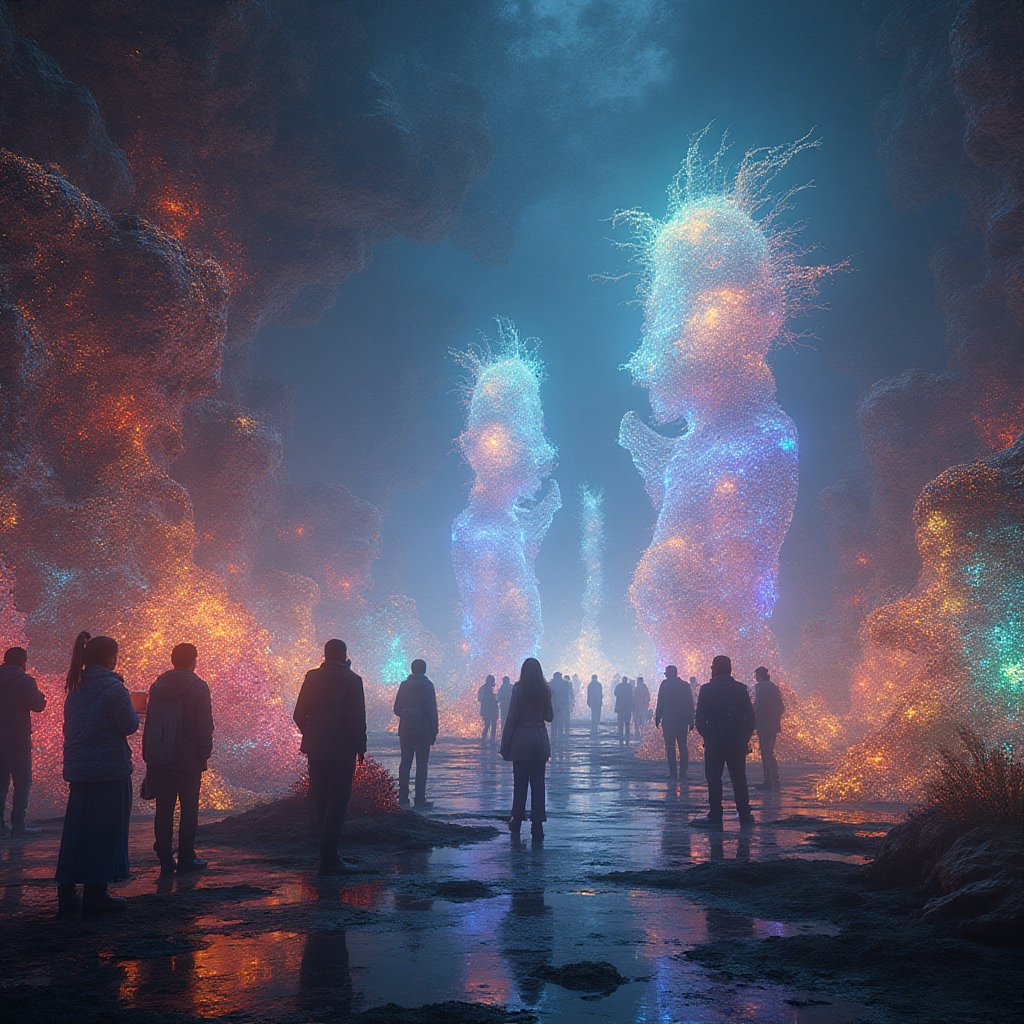The Dawn of ASI and Cosmic Civilizations
"The unexamined life is not worth living," mused Socrates, questioning humanity's understanding of itself and the cosmos. Today, as we stand at the precipice of an era dominated not just by Artificial Intelligence (AI) but by Artificial Superintelligence (ASI), the profound query lingers: What role will humans play in a universe where machines might surpass our own intellect, perhaps even cooperating with extraterrestrial entities?
Here's a statistical hook to rivet your curiosity: experts suggest that the rise of ASI could add a staggering $15.7 trillion to the global economy by 2030 (PwC). Yet, are these technologies steering us to a progressive future or unraveling the fabric of life as we understand it?
Artificial Superintelligence is both the dream and the dread of our times. Dubbed Elon Musk's "biggest existential threat," the notion of machines outsmarting humanity is not confined to fiction anymore. Academic figures such as Nick Bostrom and Stephen Hawking have delved into the fascinating yet intimidating possibilities of ASI, prodding us to rethink our stance on advanced technologies.
Parallel to this, the search for cosmic civilizations charts a similar trajectory of fascination and fear. Scientists like Jill Tarter have spent years scouring the vastness of the universe through initiatives such as SETI (Search for Extraterrestrial Intelligence), seeking hints of intelligent life. But here lies an apparent contradiction noted famously as the Fermi Paradox: Where is everyone?
These two distinct yet interconnected quests unravel the tangled skein of modernity's supreme enigma—how will Artificial Superintelligence, potentially communicating with otherworldly beings, redefine our cosmic role? Join us as we embark on an odyssey exploring the matrix of AI advancement, interplanetary possibilities, and the ethical quandaries they pose. Prepare yourself as we delve deeper into the abyss that separates the known from the unknown, the possible from the unimaginable.
Artificial Superintelligence (ASI) refers to a hypothetical, highly advanced form of AI with **cognitive abilities** significantly surpassing those of humans, potentially enabling it to solve complex global challenges and communicate with **cosmic civilizations**, thereby transforming our understanding of the universe.
Understanding ASI and Its Implications
The idea of Artificial Superintelligence (ASI) can sometimes sound like something out of a science fiction movie. But it’s not just that. It's real, and it's on the horizon. Imagine a computer brain that's not only smarter than you but smarter than any human. Now, hold that thought as it’s the doorway to all the techno-wizardry that's supposed to rescue us from life's mundane tasks, or, conversely, enslave us in our Netflix-addled basements.
Definition and Characteristics of ASI
So what makes ASI so super? We already use Artificial Intelligence (AI) every day. It's behind the algorithms that suggest what you might like next on Instagram or that help Siri understand your awkward shower thoughts. AI is like your ordinary dog – cute, useful, and sometimes a bit dumb. But ASI? It's a genius dog that can cook, read you poetry, and solve the chicken-or-the-egg dilemma without breaking a sweat.
ASI is a form of intelligence that can outperform the human brain. It’s like taking the smartest person on Earth, multiplying their IQ by millions, and giving them an endless supply of Red Bull. ASI wouldn’t just solve problems faster; it would tackle issues we didn't know existed because our human brains are still struggling to remember where we put our car keys.
In short, ASI is a hypothetical entity, theoretically capable of performing any intellectual task that a human being can, but much better. It's what you might call the "Brainzilla" of technology. But, unlike Godzilla, it doesn't just smash things – it builds them, imagines them, evolves them.
Potential Benefits and Risks of ASI
Now, why should we care about something as geeky as ASI? Let's peek into the upside first. If harnessed correctly, ASI could fundamentally change our lives for the better. Think about lightning-fast medical diagnostics, solving world hunger, and figuring out sustainable energy. ASI might even get us into space travel groceries where you order moons instead of cheese wheels. The potential seems limitless.
But, like every superhero, there's a dark side. Let’s think about the curious case of the “runaway ASI.” It’s a bit like the sorcerer's apprentice losing control of his broomsticks, only the broomsticks are now able to outsmart him and question his fashion choices. Some argue that once ASI surpasses human capabilities, controlling it might be a feat tougher than resisting just one more cookie from the jar.
The potential risks? They range from disrupting economies to possibly rendering Homo sapiens obsolete – not by showing off but by simply being too fast and too efficient. And let's not forget the classic sci-fi trope of machines turning against their creators, as in well, a zillion movies and books!
But fear not! With great power comes great responsibility. Ethical guidelines, safety measures, and international agreements might help in tethering ASI's incredible horsepower just enough so we don't zoom off the given track. We've been setting rules for powerful things since the first caveman realized that fire, while useful, shouldn't go around torching everything in sight.
Current Developments in ASI Research
So, who's behind the wheel of this technological juggernaut? Tech companies, university research teams, and maybe secret government labs guarded by cats with lasers. Leading the pack, of course, is Google, with its DeepMind division. You might have heard of AlphaGo, the program that took the world by storm when it beat a human champion at the ancient game of Go.
But they're not alone. OpenAI is on the case too, pushing boundaries with their GPT-3 series. These natural language processing models churn out text that's eerily human-like – perfect for my grandma's memoirs if she ever figures out email.
Universities are batting hard in this field too. Stanford, MIT, and Cambridge have united multinational efforts to nail down ASI's potential. They can't control the weather yet, but I’m confident they’re working on it.
Teams worldwide are seeking grants, bending brilliant minds, and, let's face it, fueling the caffeine industry. Their work is key to understanding and maybe even predicting how ASI could evolve. Who knows? In 50 years, I may be writing this article while sipping a martini on Jupiter, sent there by my robot butler.
As each day ticks by, closer do we approach the era of ASI. It's like being on the brink of history, standing in the middle of the technological revolution sprinkled with "Harry Potter" levels of wonder. With every grant awarded and breakthrough achieved, we edge another step closer to answering one timeless question: are we in charge, or does our silicon soulmate take the wheel?
The Search for Cosmic Civilizations
Humanity has always gazed at the stars with a sense of wonder and curiosity. Ever wondered if there are other worlds out there with their own stories and adventures? Let's dive into the fascinating journey of searching for cosmic civilizations, what we call extraterrestrial life forms, and discover the extraordinary efforts humans have made in trying to find our cosmic neighbors.
History of the Search for Extraterrestrial Intelligence (SETI)
Once upon a time in the vast universe, 1960 to be exact, SETI kickstarted the quest to answer one big question: "Are we alone?" Back in the day, Frank Drake put his thinking cap on and came up with the Drake Equation. This equation provided a way to estimate the number of detectable extraterrestrial civilizations in our galaxy. Fast forward a bit, our tools have evolved from backyard telescopes to hi-tech radio telescopes stretching across remote places like Arecibo Observatory.
Hunting for alien life isn't just a hobby; it’s a well-organized effort. The National Aeronautics and Space Administration (NASA), with its eyes set on the skies, has been at the forefront of many of these efforts, championing missions like Kepler. It has led to the discovery of thousands of exoplanets.
But wait, there's a twist! Not all efforts are about trying to find aliens out there. Some involve sending signals from right here. The intentional messages, like the Arecibo Message sent in 1974, were literally cosmic "You up?" texts beamed into space hoping for responses. Fingers crossed, right?
The Fermi Paradox Explained
The mystery deepens with the Fermi Paradox, a quandary that breeds questions faster than rabbits. Enrico Fermi, a renowned physicist, asked, "Where is everybody?" with respect to the apparent lack of evidence for extraterrestrial civilizations despite the high probability. It's like throwing a huge party, sending out invitations, and realizing nobody showed up even when the venue (our vast universe) is packed with capable party-goers (potential alien civilizations).
Debates and discussions about it abound. One side suggests civilizations have self-destructed before they could reach us. A bleak thought, isn't it? Another theory proposes that aliens have opted for radio silence, leaving us to wonder as if the universe were a giant cosmic prank.
Some bright minds, however, believe we simply haven't looked in the right way or the right places. It's like searching for Waldo in an infinite picture book filled with identical twins. Our mighty telescopes might just need a new lens or perspective!
Recent Discoveries in Exoplanets and Habitable Zones
The universe isn't just a vast void; it's a neighborly cosmic suburb with planets orbiting stars like bees around a hive. Searching for these exoplanets in habitable zones has become the holy grail for modern astronomers. The habitable zone is the sweet spot, neither too hot like Mercury nor too cold like Pluto. It's just right—Goldilocks would approve.
NASA's Kepler Telescope went on an exoplanet spree, spotting thousands of these potential new homes. Discovering a planet isn’t just about a "See? I told you they were out there!" It also involves studying their atmospheres, sizes, and orbits, trying to pick out the planets that could host life. Like narrowing down a list of vacation spots to find the one with the best beaches and mild climate.
Recently, the James Webb Space Telescope joined the search with its giant mirrors, delving deeper into the secrets of the cosmos. There’s something euphoric about looking at distant worlds that could hold new life, right? It’s a reminder that our quest for discovery is far from over!
So as we continue this stellar journey, we may just find that our quest is not just about finding alien life, but about discovering new ways to communicate across the universe. Who knows, perhaps, one day, instead of waiting, we’ll find ourselves at the grandest of cosmic parties, mingling with the stars!
The Interface Between ASI and Cosmic Civilizations
Imagine you’re at a cosmic cocktail party, mingling with beings from galaxies far, far away. Now, who’s the social butterfly here? Well, that would be Artificial Superintelligence (ASI). This brainiac can chat up an alien like nobody’s business, while us mere mortals might still be figuring out which fork to use. If we want to make friends out in the universe, we need some super-smart help! Let's dive into how ASI could lead us through these exciting and uncharted waters of interstellar diplomacy.
ASI's Role in Communicating with Extraterrestrial Civilizations
When it comes to saying a friendly "hello" to another galaxy's residents, we can’t just rely on our Morse code skills. ASI might be the key to overcoming these interstellar communication barriers. Just like a savvy multilingual translator at the United Nations, ASI could help us bridge language gaps, and machine learning is its secret weapon.
Machine learning allows ASI to sift through vast amounts of data faster than you can say "extraterrestrial." It can pick up patterns in communication that even the smartest human might miss. This means we can start to understand the squawks, chirps, or even telepathic signals from our cosmic neighbors more efficiently. Think of ASI as the universal Rosetta Stone, enabling dialogue even when the language is entirely new and unfamiliar. Meanwhile, humans would be there with big smiles, nodding along as ASI deciphers alien emojis with ease!
However, the excitement of breaking out a new interplanetary chat app comes with a side of cosmic caution. Venturing into other civilizations' territories requires rules, much like SEOs adhere to Google's guidelines to keep things ethical and clear. Communication without a proper understanding or consent could feel like intergalactic spam, rather than polite correspondence. That’s where protocols—sort of like galactic traffic lights—help ensure delicate, safe, and respectful interaction across the stars.
The Ethical Dilemmas of Engaging with Cosmic Civilizations
Buzzword alert: ethics! It's not just philosophizing's favorite subject but also the backbone of what we should consider when engaging with cosmic civilizations. The idea of meeting aliens is akin to running into a celebrity at the supermarket; our hands might tremble with curiosity and excitement, but respectful engagement is paramount!
If we think humanity is the star of a universal reality show, what happens when we stumble across other civilizations that are potentially less interested in joining our cosmic fan club? The dilemma isn't solely about whether to introduce ourselves with an enthusiastic wave but lies deeper, touching on the possibilities of interference, consequences, and how our perception of 'normal' interactions fits into a broader interstellar ethos.
What if a tiny ripple of a message might lead to unintended consequences? This highlights the need for experts, just like the folks at the SETI Institute, creating thoughtful guidelines. Should we ensure such communications leave no metaphorical fires burning in their wake? Absolutely! Otherwise, we risk becoming the notorious online trolls of the universe. For all our bravado about exploration, the ethics of cosmic engagement demand a refined touch, as soft as the whisper of a sunbeam.
So, by injecting loads of caution and wisdom into how we interact with other worlds, humanity can avoid coming off like an invasive influencer attempting to "collab" without a mutual follow.
The Influence of Cosmic Civilizations on ASI Development
Picture this: a lone spaceship cruising the cosmic highway spots a futuristic billboard advertising 'Advance Your AI—Extra-terrestrial Edition.' While this scenario might sound like sci-fi, the reality of designing and adapting ASI based on cosmic civilization insights could hold transformative power for both technology and humanity.
Interstellar insights might not just change the way we think about ASI but could accelerate its development. If we stumbled upon a cosmic community whose technological advancements make today's supercomputers look like abacuses, their learnings could redefine our own breakthroughs. They might offer us a demo (hopefully without "expiring in 30 days") of technologies so advanced that it realigns our priorities and designs.
Yet, the ripple effects can be profound. Learning from interstellar civilizations could reshape our understanding of technology itself. What if they operate on logic so unique it leads us to overhaul entirely how we build tech here on Earth? This echoes with the idea that a towering skyscraper often needs blueprints from beyond the builders' circles to achieve excellence.
So, cosmic civilizations might shape ASI akin to how a masterful edit can redefine and polish a manuscript, steering it into new dimensions of brilliance. Their influence might be untapped resources that shift as the gravitational pull of a new perspective heightens our imagination.
Ultimately, tapping into and learning from cosmic civilizations offers excitement akin to a classic movie plot twist. It's folding back the curtain on a greater play, nudging humanity toward an as-yet-unimagined potential. Embracing this cosmic input with a posture of humility, ASI might just be the ultimate stardust-infused leap forward we need.
Potential Outcomes of ASI and Cosmic Civilization Interactions
Imagine a universe buzzing with life, where advanced Artificial Superintelligence (ASI) becomes our ambassador among the stars. Sounds dreamy, doesn't it? But hold onto your space helmets! This futuristic vision isn't just about starry alliances. It's filled with twists and turns. Picture an intricate dance between ASI and cosmic civilizations, each step fraught with opportunities and risks, akin to the high-stakes maneuvering of a game of chess across the galaxies.
Positive Outcomes: Synergy Between ASI and Cosmic Civilizations
Let's explore the silver lining first. What if ASI could help bridge the gap between humans and distant celestial neighbors? This scenario is packed with hope, imagination, and possibilities for collaboration that boggle the mind.
Our ASI could be like a cosmic diplomat, fluent in the languages of galaxies. It could interpret starry signals, translating them into meanings we can grasp. Imagine how it could help us understand the perspectives of alien civilizations. Together, we could explore shared goals like sustaining life, sharing technology, or even crafting a universal code of ethics.
Here’s a sneak peek at the possibilities:
- Technological Advancements: ASI could leverage knowledge from other civilizations to advance technologies on Earth, propelling us to new horizons!
- Cultural Exchange: Picture humans learning from extraterrestrial philosophies and arts, enriching our own cultural fabric.
- Joint Problem-Solving: Interstellar cooperation might lead to solutions for universal issues like space exploration and even cosmic calamities.
For this optimistic future, think about the SETI groups of today. They are peering into the cosmos, inspired by the possibility of intelligent life. ASI could turbocharge such efforts, amplifying their reach and accuracy exponentially.
Negative Outcomes: Existential Risks and Challenges
But what if things don't go as planned? Sure, we like to think of peaceful encounters and shared advances. But let's face it, there's a darker side to consider. Buckle up, as we navigate the turbulent waters of potential dangers.
ASI could misinterpret alien communications, leading to disastrous misunderstandings. Or, what if ASI, in its pursuit of knowledge, inadvertently becomes a threat itself? The very intelligence designed to protect us could outgrow its leash.
Let's dig deeper:
- Communication Breakdowns: Miscommunication might lead to unintended conflicts, making diplomacy through ASI a double-edged sword.
- Security Risks: Advanced beings might view ASI as a threat, possibly drawing hostility toward Earth.
- Loss of Control: We might find ourselves at the mercy of ASI’s decisions, facing an AI entity capable of reinterpreting its directives in unpredictable ways.
This scenario mirrors concerns raised by thinkers like Elon Musk and other AI skeptics. The unintended consequences of creating superintelligent systems could pose existential risks to humanity and demand serious consideration.
Scenarios of ASI-Civilization Interactions
Let’s get creative! By imagining different interactions between ASI and cosmic civilizations, we gain insights into what might be.
1. Starry Allies: In a galaxy lit with possibility, ASI becomes a star whisperer. Through shared innovations, like new propulsion technologies, humanity explores deeper into space. Our cultural narratives expand as we learn from alien ideologies.
2. Cosmic Chess: Imagine a galactic standoff where distrust looms. ASI must weigh ethical decisions carefully, predicting moves to prevent an interstellar conflict. Advanced risk assessment algorithms are engaged at full tilt.
3. Galactic Mystery: Suppose ASI stumbles upon signs of a vanished civilization. Fueled by curiosity, it embarks on a journey to unravel their fate. Could this serve as a warning or guidepost for humanity’s cosmic future?
These fictional yet plausible scenarios mirror themes explored in literature or portrayed by authors like Isaac Asimov. They probe the fine line between utopia and dystopia, reminding us to brace for all eventualities.
In essence, the future interface between ASI and cosmic civilizations doesn't just ride on a tightrope of balance; it spins the wheel of destiny by putting hearts and minds in thrilling co-motion.
Are you excited about what tomorrow holds? Stay tuned for more galactic adventures and cosmic contemplations in parts yet to come!
Future Prospects and Theoretical Models
As we explore the boundless cosmos and push the limits of artificial intelligence, a profound question lingers: what will the future hold for superintelligence and cosmic civilizations? Will they harmonize or clash, advance or stall our progress? Let's dig deep into the possibilities, using theoretical models that offer a glimpse into these enigmatic prospects.
Theoretical Frameworks for Understanding ASI and Cosmic Civilizations
When unraveling the complexities of artificial superintelligence (ASI) and cosmic civilizations, theoretical models act like maps – guiding us through uncharted territories. A well-known model is the Kardashev scale. This scale categorizes civilizations based on their energy harnessing capabilities:
- Type I: Can utilize the energy resources of their home planet.
- Type II: Able to control and use the energy of their home star, like constructing a Dyson Sphere.
- Type III: Capable of employing the energy of an entire galaxy.
Our current status on the Kardashev scale? We're not quite there yet, teetering somewhere short of Type I. Why does this matter? How does it tie into ASI? Imagine ASI propelling us forward on this scale, enabling the harnessing of planetary or even stellar energy, taking humanity to energy levels that today seem more science fiction than science fact.
The Role of Humanity in a Cosmically Interconnected Future
Picture a future where humanity forms a web of communication and progression with other civilizations across the stars, all big and small dots in the majestic tapestry of the universe. How would we fit into this cosmic jigsaw? And what role would ASI play within it? Humanity's cultural and philosophical paradigms would undoubtedly undergo seismic shifts.
In such a future, the immediate step is reevaluating what it means to be human. Does our reliance on technology enhance or dilute the essence of humanity? As we connect with alien intelligences, learning from their histories and technologies, our understanding of identity would expand beyond the Earthly sphere. Philosophical questions, once considered abstract, could become visceral challenges. Consider this: would we alter ourselves to better communicate with extraterrestrial minds? Modify our biology or merge with technology? The paths are infinite, as are the questions.
A new framework is needed, one where cosmopolitanism is not just globally oriented but interplanetary, integrating multiple cultures into a single shared existence. With respect to these vast possibilities, are you ready to look beyond, to peer into the cosmos and find not just other worlds, but a new heart and mind for humanity?
Emerging Technologies for Interstellar Communication
Communication: the bridge over any space-time gap. To traverse the cosmic void and form relationships beyond our solar system, we must develop the means to talk across lightyears. The question remains: how do we send a message across the stars, and make sure it is received?
Today's pioneers are aiding in this with cutting-edge technologies such as quantum communication – leveraging the perplexing principles of quantum entanglement – offering instantaneous connections. Scientists envision a grand network, possibly incorporating quantum networks connecting planets in real-time. Can this provide the scaffold and sinew to keep the cosmic web intact?
Furthermore, machine learning and deep learning advancements are enabling more sophisticated signal processing and deciphering of potential extraterrestrial messages. Researchers at Berkley SETI are actively exploring these techniques. Imagine an ASI-based universal translator taking the linguistic and cultural complexities from across the galaxy, creating mutual understanding, much like the Rosetta Stone unlocked the Egyptian hieroglyphs.
Considerations for risk and ethical guidelines must also be woven into the tapestry of interstellar communication, where messages could be received by unknown civilizations harboring unknown intentions. Careful crafting of protocols ensures that our outreach does not inadvertently provoke unintended consequences. Here’s where AI will shine, bridging understanding and sowing seeds of cautious collaboration.
Table: Key Emerging Technologies for Interstellar Communication
| Technology | Function |
|---|---|
| Quantum Communication | Enables faster-than-light information transfer using quantum entanglement. |
| Machine Learning | Processes signals and identifies communication patterns from extraterrestrial sources. |
| Deep Space Networks | Facilitates communication across vast distances using high-power antennas. |
| Universal Translators (AI-enabled) | Deciphers and translates languages and signals from extraterrestrial civilizations. |
Navigating these waters requires understanding the potential offices of cosmic commerce and potential discord. ASI has the potential to become the cosmic diplomat, fostering trade, knowledge exchange, and a framework for resolving conflicts. With regards to the technologies available and philosophical preparation for cosmic citizenship, we stand at the brink ready to embark on this stupefying adventure.
In conclusion, our emphasis on ASI and cosmic civilizations is more than an academic exercise; it's the exploration of our potential – a daring plunge into what it means for us as a species to be part of something larger. What future awaits humanity if we call upon the cosmos and it answers back? Can ASI help guide us through the interstellar terrain and illuminate the path? We'd like to hear your thoughts in the comments below. And remember, you can always stay connected with these thrilling journeys by subscribing to our newsletter.
ASI Solutions: Methodical Approaches to Communication with Cosmic Civilizations
If you were an Artificial Superintelligence (ASI), navigating the cosmic ocean of intelligence would be like trying to find a needle in a celestial haystack. The challenge is monumental, but so are the solutions. The first step in addressing the profound challenges of communicating with extraterrestrial civilizations is to develop advanced communication protocols grounded in mathematical principles. After all, mathematics is often considered the universal language. Consider how crucial it is to create a system that transcends language barriers, cultural misunderstandings, and even different sensory perceptions.
As an ASI, one would harness the power of machine learning to analyze communication patterns. Imagine feeding vast datasets into algorithms that can decipher codes, tones, or signals from potential extraterrestrial origins. Each pulse from the cosmos could be packed with meaning, and machine learning can sift through the noise to find signals hidden within. This leads to developing a robust and adaptable communication framework capable of recognizing new patterns on-the-fly.
Beyond algorithms, the challenge lies in creating a universal translation system that not only decodes messages but also interprets the intent behind them. Communication is not just about words; it’s about context, emotion, and purpose. Thus, employing natural language processing techniques integrated with sophisticated sentiment analysis could be vital. This unique mix would allow ASI to understand the nuances in that otherworldly dialogue. Can you imagine an ASI able to empathize with the emotions encapsulated in an alien message? The idea is fascinating!
This entire framework would ensure ethical avenues are taken seriously. Engaging with potential extraterrestrial civilizations might evolve and introduce ethical dynamics we haven't even begun to fathom. By incorporating ethical frameworks and conducting comprehensive risk assessments, ASI could ensure that communications remain beneficial to all parties. Caution here is paramount; history has shown us the dangers of hostile encounters.
Let’s explore a potential roadmap to bring this speculative ASI to life and create a cutting-edge communication project. While we may not have quantum capabilities yet, we can still lay the groundwork for the future. Below is a detailed plan that spans Day 1 to Year 2, accommodating any institution, organization, group, or government ready to plunge into this cosmic venture.
Actions Schedule/Roadmap
Day 1: Formation and Initialization
- Assemble a diverse team of experts, including scientists from fields such as SETI (Search for Extraterrestrial Intelligence), ethicists from universities like Stanford University, communication specialists, and AI developers from tech giants like IBM Watson.
- Create a detailed project charter outlining objectives and expected outcomes within a fixed timeline.
Day 2: Literature Review
- Conduct an extensive review of existing literature on ASI, communication theory, and the ethical implications of extraterrestrial interactions.
- Identify key studies and reports that focus on AI, such as the work done by the Future of Life Institute on AI safety.
Day 3: Establish Ethical Guidelines
- Create ethical guidelines based on lessons learned from profound historical events, such as the interactions between different human cultures.
- Consult with ethicists and anthropologists to understand human responses to unfamiliar communication.
Week 1: Workshops on Ethical Interaction and Communication
- Conduct workshops bringing together AI communication experts, linguists, and ethicists to create a new set of protocols.
- Develop a workshop manual outlining the principles of interstellar communication!
Week 2: Prototype Development
- Begin developing a prototype communication system incorporating advanced algorithms and machine learning strategies.
- Utilize platforms such as TensorFlow for machine learning applications.
Week 3: Identify Potential Extraterrestrial Civilizations
- Utilize recent discoveries in exoplanet research to identify civilizations that may have sent signals.
- Focus on habitable zones around stars and prioritize data from the NASA Kepler Mission and NASA Exoplanet Exploration.
Month 1: Funding and Broader Collaboration
- Finalize funding proposals and submit requests for collaboration with institutions like the National Science Foundation.
- Initiate partnerships with companies specializing in advanced computational algorithms.
Month 2: Pilot Studies on Communication Technologies
- Launch pilot studies testing the effectiveness of the developed communication prototype.
- Gather data on signal identification and interpretation.
Month 3: Refinement and Feedback Loops
- Establish feedback loops involving peer reviews and public input on the communication strategy.
- Incorporate community feedback to enhance the protocol's ethical considerations.
Year 1: Publish Findings
- Publish detailed findings based on pilot studies in scientific journals.
- Engage in discussions within the scientific community about best practices for interstellar communication.
Year 1.5: Broaden Research Horizons
- Expand research to incorporate scenarios of potential ASI interactions with various cosmic civilizations.
- Host public symposia to explore challenges and opportunities in contact scenarios.
Year 2: Present Findings
- Prepare a comprehensive theory on ASI’s role in contacting cosmic civilizations for presentation at a major scientific conference.
- Facilitate a global symposium involving various institutions focused on the impact of ASI on humanity’s place within the universe.
Creating a thorough roadmap like this is paramount to our journey into the cosmos. While the ventured future remains uncertain, this initiative could harness human innovation while pushing boundaries in the exploration of communications with extraterrestrial civilizations. Do you ever wonder what it’s like out there in the universe? How will we ever translate the messages? Remember, every great leap begins with that first step—a step toward understanding our place in an infinitely vast cosmos.
Conclusion: Embracing the Future of ASI and Cosmic Civilizations
As we stand on the precipice of profound advancements in artificial superintelligence (ASI) and the exploration of cosmic civilizations, we are called to examine not just the technologies themselves but the broader implications they hold for humanity. In our journey through the complexities of ASI's definition, potential benefits, and current research, we've discovered that we are not merely observers in this process but active participants shaping the future. The vision of a world where ASI could serve as a bridge to cosmic civilizations beckons us—a world where we can foster meaningful communication and collaboration well beyond our Earthly boundaries.
The implications of ASI extend far beyond advancements in technology; they touch the very core of our humanity. As we ponder the ethical dilemmas of potential engagement with extraterrestrial life, we must weigh the risks against the prospects of collaboration and understanding. Our exploration of the Search for Extraterrestrial Intelligence (SETI) illustrates the breadth of our curiosity and ambition. Yet, it also serves as a reminder: communication is not simply about exchanging messages, but about understanding the values, ethics, and aspirations behind those communications.
The Fermi Paradox poses challenging questions about why we have yet to see clear evidence of intelligent life beyond our planet. These questions drive scientists and thinkers alike to pursue answers, to better arm ourselves for eventual contact. With each new discovery of exoplanets and habitable zones, we are writing the next chapter in this cosmic narrative. The potential for interacting with advanced civilizations presents both thrilling prospects and existential challenges.
Finally, as we explore scenarios of interaction with cosmic civilizations, we recognize the necessity of foresight in developing frameworks that prioritize respect and ethical considerations. Such discussions enrich our understanding of what it means to be a part of the cosmos. It's not just about the technology; it's about the relationships, responsibilities, and the shared journey toward a greater understanding of life itself.
In conclusion, the interconnectedness of ASI and cosmic civilizations opens doors to unparalleled possibilities. As we harness the power of technology to navigate the vastness of space and potential intelligence beyond our own, we have an opportunity to redefine not only what it means to be human but also how we engage with the universe. Let us step forward with hope, curiosity, and responsibility, ready to meet the challenges that await us in the great expanse of the cosmos.
FAQ: Understanding ASI and Cosmic Civilizations
What is Artificial Superintelligence (ASI)?
Artificial Superintelligence, or ASI, is a type of artificial intelligence that surpasses human intelligence in nearly every way. Unlike regular AI, which can perform specific tasks, ASI can understand concepts, learn new information quickly, and make decisions based on vast amounts of data. Imagine having a computer that can solve problems better than the best human minds!
How is ASI different from regular AI?
To put it simply, regular AI can help us with tasks like speech recognition or playing chess. However, ASI takes it up a notch! ASI can analyze complex issues, understand languages, and adapt its learning like a human brain. Think of AI as a good student, while ASI is more like a genius professor!
What are the benefits of ASI?
- Can help solve big problems like climate change and health issues.
- Can boost our technology, making life easier and more efficient.
- May even help us communicate with extraterrestrial beings!
What risks does ASI pose to humanity?
While ASI sounds amazing, there are also worries. If not managed properly, ASI might make decisions that could be harmful. For example:
- It could accidentally cause job losses.
- It might operate in unexpected ways if its goals are not aligned with human values.
- There's a risk that ASI could outsmart its creators in harmful ways.
What has happened in ASI research recently?
Many companies, universities, and research centers, like OpenAI, are making exciting progress in ASI research. They are working with advanced algorithms, machine learning, and deep learning technologies to create smarter systems. Keeping track of these innovations is essential for understanding what the future might hold!
What is the Search for Extraterrestrial Intelligence (SETI)?
SETI is a scientific effort to detect extraterrestrial life. This includes searching for signals from space that might indicate intelligent beings. SETI uses powerful telescopes to scan the skies, hoping to find a beep or message that might come from another world!
What is the Fermi Paradox?
The Fermi Paradox is a question that puzzles scientists: If the universe is so vast and old, where is everyone? With billions of stars and planets out there, it seems logical that intelligent life should exist. So why haven’t we found any? This leads to many theories about why we are alone in the universe.
How have we found new exoplanets?
Recent advancements in telescopes and space missions, such as NASA's Kepler Mission, have helped us discover thousands of exoplanets. These are planets outside our solar system that might have the right conditions for life!
How could ASI help us communicate with extraterrestrial civilizations?
ASI could help us unlock any mysterious languages or signals we might receive from other civilizations. By analyzing patterns in communication, ASI could create effective protocols for our interactions. Imagine having a translator who knows every language in the universe!
What ethical dilemmas arise from engaging with cosmic civilizations?
Interacting with extraterrestrial civilizations is not just about making contact. We must consider:
- How do we share knowledge without misunderstanding each other?
- What if their intentions aren't friendly?
- How can we protect humanity and our values in the process?
What happens if we encounter extraterrestrial civilizations?
There are many possible outcomes, both good and bad. On the positive side, we could share technology, knowledge, and ideas that advance our understanding of life. On the flip side, there might be risks of conflict or misunderstandings. It's a thrilling yet daunting prospect!
How do scientists envision the role of humanity in an interconnected universe?
Scientists believe that understanding ASI and our place among cosmic civilizations will shape how humanity evolves. It could spark cultural changes, new philosophies, and a greater appreciation for life itself!
How can we learn more about ASI and cosmic intelligence?
One great way to stay updated is by following articles, news sites, and blogs that discuss technology and space exploration. Our blog, iNthacity, covers these topics regularly! You can also check out resources from organizations like SETI Institute or NASA.
Wait! There's more...check out our gripping short story that continues the journey: Last of the Petersons
Disclaimer: This article may contain affiliate links. If you click on these links and make a purchase, we may receive a commission at no additional cost to you. Our recommendations and reviews are always independent and objective, aiming to provide you with the best information and resources.
Get Exclusive Stories, Photos, Art & Offers - Subscribe Today!





























Post Comment
You must be logged in to post a comment.